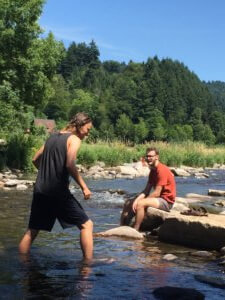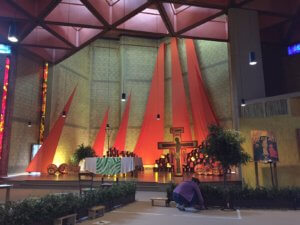
We have received an awesome gift. It comes again though the blessing of friendship (see earlier post). Our adventure in Europe landed us in Freiburg, Germany, where dear friends, Eric, Monika, and Johannes Aplyn live and David was vacationing/visiting his family. David, like Gabe, had just finished his sophomore year of college. He attends the University of Vermont. David was and is one of Gabe’s best friends. Their link began in club soccer and cemented at Berkeley High in the IB school. We had the privilege of hosting David last summer in our home, since his parents had moved to Germany.
This year, we decided to make the trek to Germany following the Camino. Our two families maintain a bond of friendship from years of hanging out around the edge of soccer fields and in carpools. We also just really like each other.
The Aplyns are amazing hosts. They have made space for us here in their home in Freiburg and given us access to their car and their bikes. Freiburg is a lovely city, a University town on the edge of the Black Forest. We have enjoyed much of what Freiburg has to offer, from visiting the old town, the delightful farmer’s market and touring through museums and the gorgeous cathedral to hiking in the local hills and playing in the river.
This part of our trip was also loosely planned. We were not sure when we would finish the Camino (we left wiggle room for sick days, injury days and other possible disruptions). It turns out that we finished on time and got to Freiburg by the 3rd of July.

Gabe, Jason and I spent a few days in Freiburg with all of us together. Then, we said good bye to David and Gabe. They headed off for other European adventures without us. Jason and I needed to figure out what to do with all of our extra time.
Our next commitment was an Air BnB in Avila for the 14th. We thought about staying longer in Freiburg or touring around the Black Forest, when the topic of Taizé came up. Monika is a devout Catholic and encouraged us to borrow their car and take a few days at this famously nurturing prayer center.
We immediately went online to request a reservation and now have the permission from the Taizé monks to come for three days and enjoy a tent spot (Monika and Eric are lending us a tent and all the camping gear we might need) so that we might fellowship with other prayer pilgrims as well as the brothers who have devoted themselves to worship and prayer.
This spontaneous opportunity feels like a gift dropped on our laps. Taizé is only a three hour drive away from Freiburg. It’s a very doable short trip from here.
We are incredibly grateful to the Aplyns and to God who orchestrates such divine appointments. We are going into the experience with open hearts. In fact, I know few details about Taizé except that many older and more mature Christians I admire speak highly of the community and the teaching on prayer that is offered in this historically holy location. I hope to learn more soon.
FLASH FORWARD

We are back from Taizé. We did not have access to internet for a couple of days (a good thing) and our link here in Freiburg has been on and off as well. I did manage to post a couple of photos on Facebook since my Spanish SIM card still contains data, but we use it sparingly.
I have many thoughts and feelings on the prayer experience at Taizé and some unprocessed thoughts and feelings as well. Jason and I will continue to talk.
Overall, we were impressed with the organization, the ministry of the monks who follow in the footsteps of Brother Roger Schutz, born in Switzerland in 1915.
We experienced a deep prayer culture and a Christ-centric, yet gentle pulse of gospel love throughout the community.

Also, the place was packed! We think there were about 2000 people on site. We lived in a tent for the few days we were there. Youth packed out the buildings and other tent/camping areas. It was incredible, the high energy and the devotion to prayer. Yet, no one was somber. It’s like a wild party punctuated with three, one-hour celebrations of contemplation, prayer and worship.
Most of youth arrive in groups and most were from around Europe. A few Americans, South Americans and Africans made the mix truly global. Jason and I guess the average age of the teeming masses was around 22-years-old. Since we’ve worked with and around college students for most of our adult lives, this reality was incredibly heartening for us.
Why and how did Taizé begin? First of all, it is just the name of the town where Brother Roger had been ministering since World War II. He played an active role in helping the people of France ad Germany heal and reconcile. Then, in the 60s, the locale was host to thousands of spiritually hungry youth. I’m still unsure of how he got those first crowds, but something about Brother Roger’s invitation struck a chord with the 60s generation and Taizé became the Woodstock of European Christianity.
We learned a little about that in our three days. It was Brother Roger who anticipated a movement within the Catholic Church that preceded Vatican II. The opportunity he saw arrived on his doorstep in the huge numbers of young people aching for change in their world and in the church, aching for spiritual meaning. Those who found it difficult to match up their post-war existence with the antiquated views in the traditional church came to this man for answers. Brother Roger believed the 60s generation was a part of a larger demographic and values shift in the world and that these youth needed a voice in the church. Through Taizé, he gave them that voice and represented them before the Catholic hierarchy. Pope John XXIII called him a prophet.
This idea of youth needing a place to speak and be heard never left him as Taizé’s reputation grew. The site is about 100 kilometers from any city of note in France. It is off that beaten track, in the heart of the Burgundy countryside. There is beauty and nature around you at Taizé, but there are no big cities. So why do so many people come?
The Taizé prayer style is relatively simple. Three times per day, the entire camp comes together in the santuary. The santuary is a building that has been expanded multiple times. The space is used smartly and creatively. It is a practical building with a simple beauty and appeal to youth especially. (AKA, it’s not a cold old stone edifice)

Most people sit on the floor. Many use portable kneelers. Prayers are sung in various languages. Jason and I sang prayers in over seven languages during our visit. They’re short and repetitive songs, so it wasn’t that difficult to learn a few words in Polish, German, Latin, etc. The Bible reading takes place early in the service, also in multiple languages. After this, a time of silence is given for prayer. The room virtually hums with intensity during these minutes.
The morning service includes taking communion, which is offered liberally to those who are interested, not necessarily Catholic. (Brother Roger felt strongly about the limits of Vatican II in this area…in restricting the Eucharist to confessing Catholics alone).
In the “free time” there are many options to discuss issues in small groups, take part in a Bible Study or enjoy the community. I saw very few young people doting on their phones. That, in and of itself, made me very happy.
During the evening prayer service, a time is given for individuals to receive one on one ministry from the brothers, the monks. There are a group of nuns on site to meet with women. The monks/brothers are present in every service. They sit and pray in the center-front of the santuary. They lead the singing and they read the Bible, but other than that, everything else at the camp is done by the young people. Everyone who comes takes on a job, whether that be washing dishes once a day or helping to clean bathrooms or sweeping the floors of the various meeting rooms. It’s just expected and it seems to work seamlessly.
If nothing else, I did notice how well organized all of the operations were at Taizé. The ministry has had many years to figure this out and they’ve managed to make it feel normal to ask a 16-year-old to work as a part of his/her stay. All the youth there seem to feel comfortable bossing around the adults and the other youth. They have been given agency.
Financially, the ministry operates on donations. I believe most of the attendees give generously toward their stay, but some give nothing. The monks make beautiful pottery and sell for their own livelihood.
Jason and I are pondering how the experience will change us. Unlike the Camino, this style of prayer was among the crowds. Silence plays a part in the prayer time, in fact, a central role, but the santuary is still filled with 2000 individuals. It is amazing on one level to pray with so many, but also a different kind of community experience than the Camino. The pilgrimage on the road in Spain was solitary. It felt meandering at times and spacious. Physically, there were intense challenges and encounters with nature virtually every moment of every day, but Taizé has impacted our senses in a different way. It too was a compelling way to be a pilgrim
I think Jason will want to write his own blog post about Taizé and we will take more time for reflection while in Ávila.